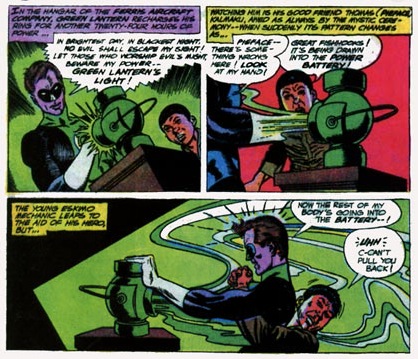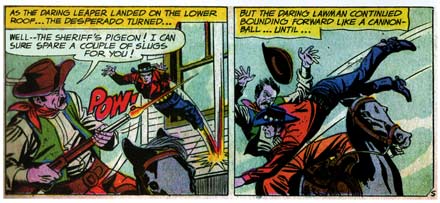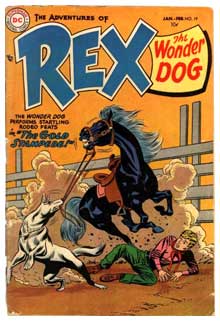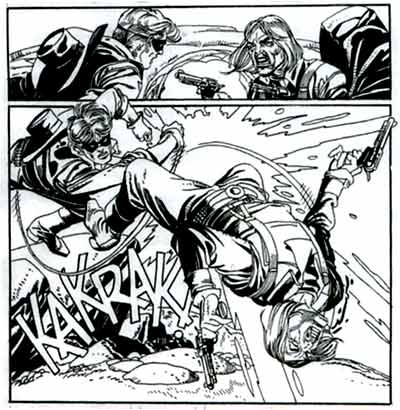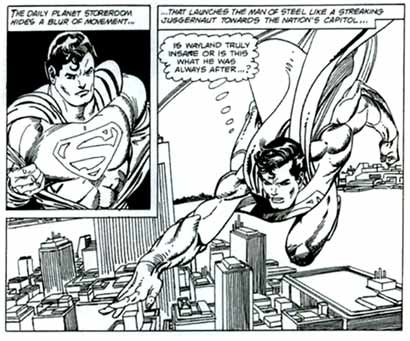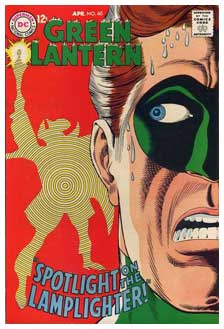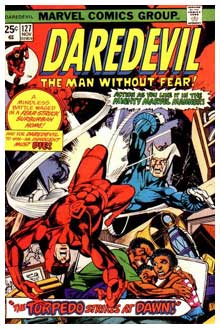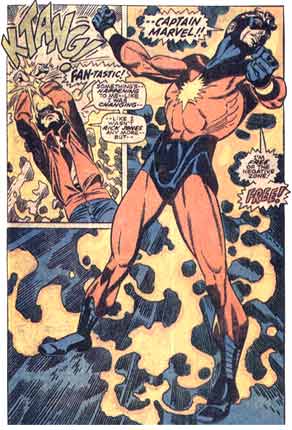'The Green Lantern', by Gil Kane (1964).
Gil Kane was one of the masters of superhero comics, who has worked extensively for both Marvel and DC. Kane, whose real name was Eli Katz, was born in Riga, Latvia, in 1926. He moved with his family to New York in 1930, where he grew up in Brooklyn. He soon developed an avid thirst for comics, reading everything he could get his hands on, especially Dick Calkins' 'Buck Rogers', Hal Foster's 'Tarzan', Chester Gould's 'Dick Tracy', Milton Caniff's 'Terry and the Pirates' and Alex Raymond's 'Flash Gordon'. He also credited John Spranger as "at one point the best artist I ever saw in comics." (Comics Journal issue #186, April 1996) and additionally admired Jean-Claude Mézières and Dan Spiegle.
'Johnny Thunder'.
In 1942, at the age of sixteen, he found a job in the comic shops of Jack Binder, taking penciled comics and drawing borders and word balloons in them. Later, he moved on the shop of Bernard Bailey and eventually became an independent artist, contributing to companies like MLJ Magazine, Prize Comics and Street & Smith.
Covers for All Star Western and Rex The Wonder Dog.
After a while, Kane also took up penciling comics himself, and some of the earliest features he worked on are 'Inspector Bentley of Scotland Yard' in Pep Comics, 'Scarlet Avenger', 'Blackstone the Magician' and 'The Glamorous Teen Queen Candy'. Kane worked together with a number of great comic artists of that time, like Jack Kirby and Joe Simon, on titles like 'Wildcat' and 'Sandman' for National/DC. In 1943-44, he also did his first work for Timely/Marvel, including 'Red Hawk', 'The Vision' and 'Young Allies'.
'Superman', by Gil Kane.
At the same time, Kane attended the School of Industrial Art, where Carmine Infantino and Harvey Kurtzman were his classmates. In 1943, Gil Kane quit school to devote more time to his assignment work. A year later, he joined the army, where he tried to get a job as cartoonist on the camp newspaper. He returned from the Philippines in 1945, and immediately took up his work as a comic artist again, using many different pseudonyms, such as Pen Star, Scott Edward and Gil Stack, eventually sticking with the name Gil Kane.
'Johnny Thunder'.
Kane, always working very hard to improve his artwork, worked on various styles of comics, like westerns ('Johnny Thunder', 'Hopalong Cassidy', 'Matt Savage', 'The Trigger Twins', 'Nighthawk'), science fiction stories ('Rex the Wonder Dog', 'Rip Hunter', 'Captain Comet', 'Space Cabbie'), comics about movie stars and, most notably, superheroes. He reprised classic superheroes during the Silver Age of Comics, such as 'Green Lantern' (from 1959) and 'The Atom' (from 1961), for DC Comics. He succeeded Steve Ditko on 'The Hawk and the Dove' and Wallace Wood on 'Captain Action'.
'Superman'.
Later, for Stan Lee's Atlas line, he reinterpreted the 'Hulk', 'Thor' and 'Captain Marvel'. Starting in 1970, he had a notable run on 'Spider-Man', drawing among others the key episode in which Gwen Stacy was killed. Throughout the 1970s, Gil Kane made over 800 covers for comics such as 'Daredevil', 'Ka-Zar', 'Savage!', 'Ghost Rider' and many, many others. His additional pencil credits include a great many titles like 'Black Panther', 'The Micronauts', 'Daredevil', 'Warlock', 'Conan' and 'John Carter of Mars'.
'The Green Lantern'/'Daredevil'.
Besides his work for DC and Marvel, Kane worked on 'Undersea Agents' and 'Thunder Agents' for Tower Comics, made the sword & sorcery graphic novel 'Blackmark' for Bantam Books and did black-and-white horror stories for the Warren magazines. His syndication credits include the daily 'Flash Gordon' for King Features in the 1960s, the daily strip 'Star Hawks' with Ron Goulart in the 1970s and some 'Tarzan' Sunday pages.
'Captain Marvel'.
In the 1980s, Kane worked mostly for DC, doing runs on 'Superman', and 'Sword of the Atom', while also doing character designs for various Hanna-Barbera animated series and contributing to the 'Superman' animated cartoon series. In 1989, he did a comics adaptation of 'The Ring of the Nibelung' for DC, and four years later, he adapted 'Jurassic Park' to comics with George Perez as inker. In 1994, he was present at Malibu Comics with 'Edge'. Among his latest works are two episodes of 'The Power of Shazam' (DC), 'The Life Story of Flash' (Marvel) and 'Superman: Distant Fires' (collection Elsewords).
'Jungle Book'.
Dynamic figure work, emotionally charged characters, and innovative staged fight scenes are his trademark. Kane became one of the most thoughtful spokespersons for the comic industry, helping them to gain the respect and attention they have long deserved. Gil Kane died of complications from cancer on 31 January 2000.
Gil Kane was an influence on Neal Adams, Tom Beland, John Romita Sr. and Jim Woodring.
Gil Kane, 1941.



